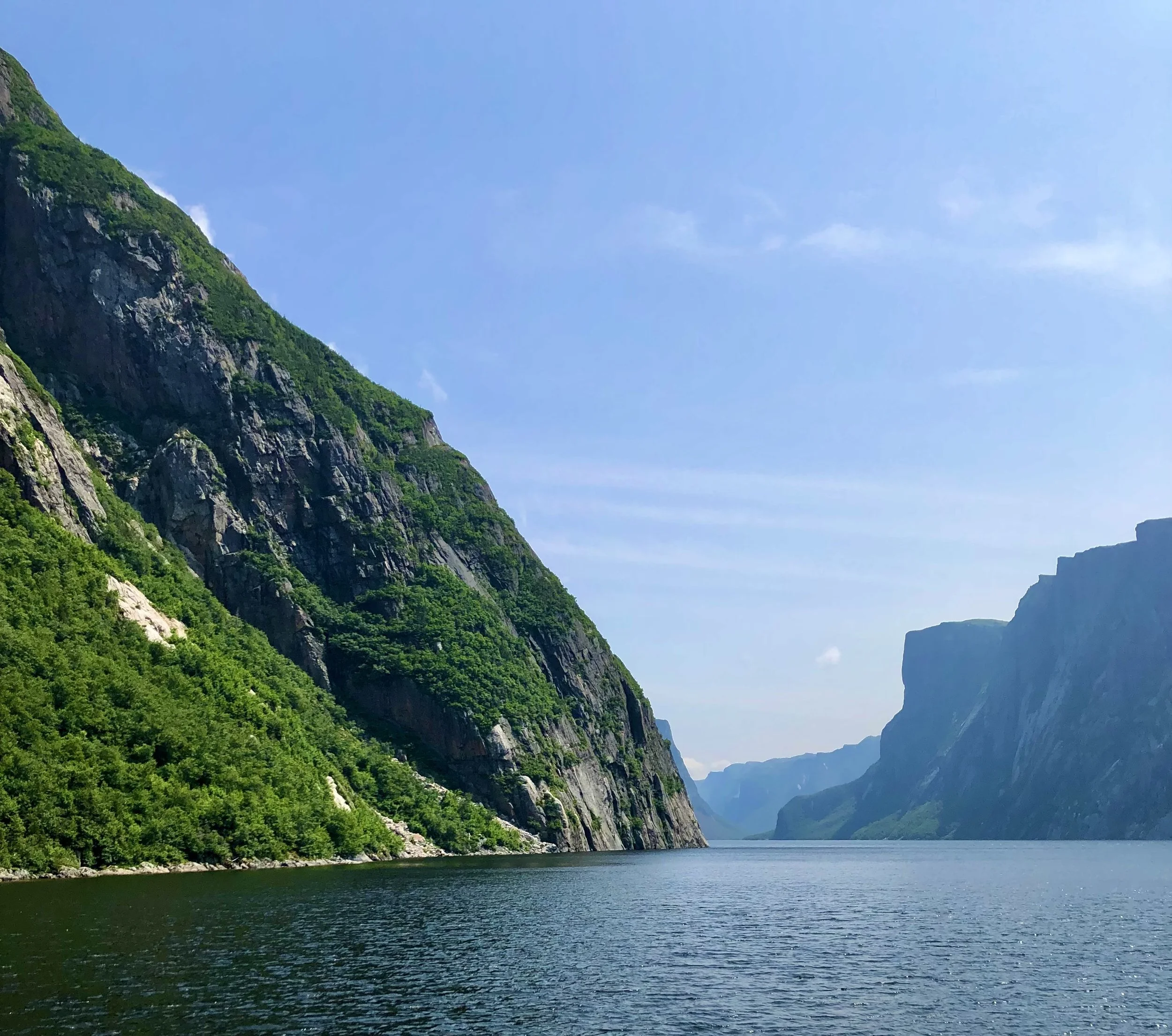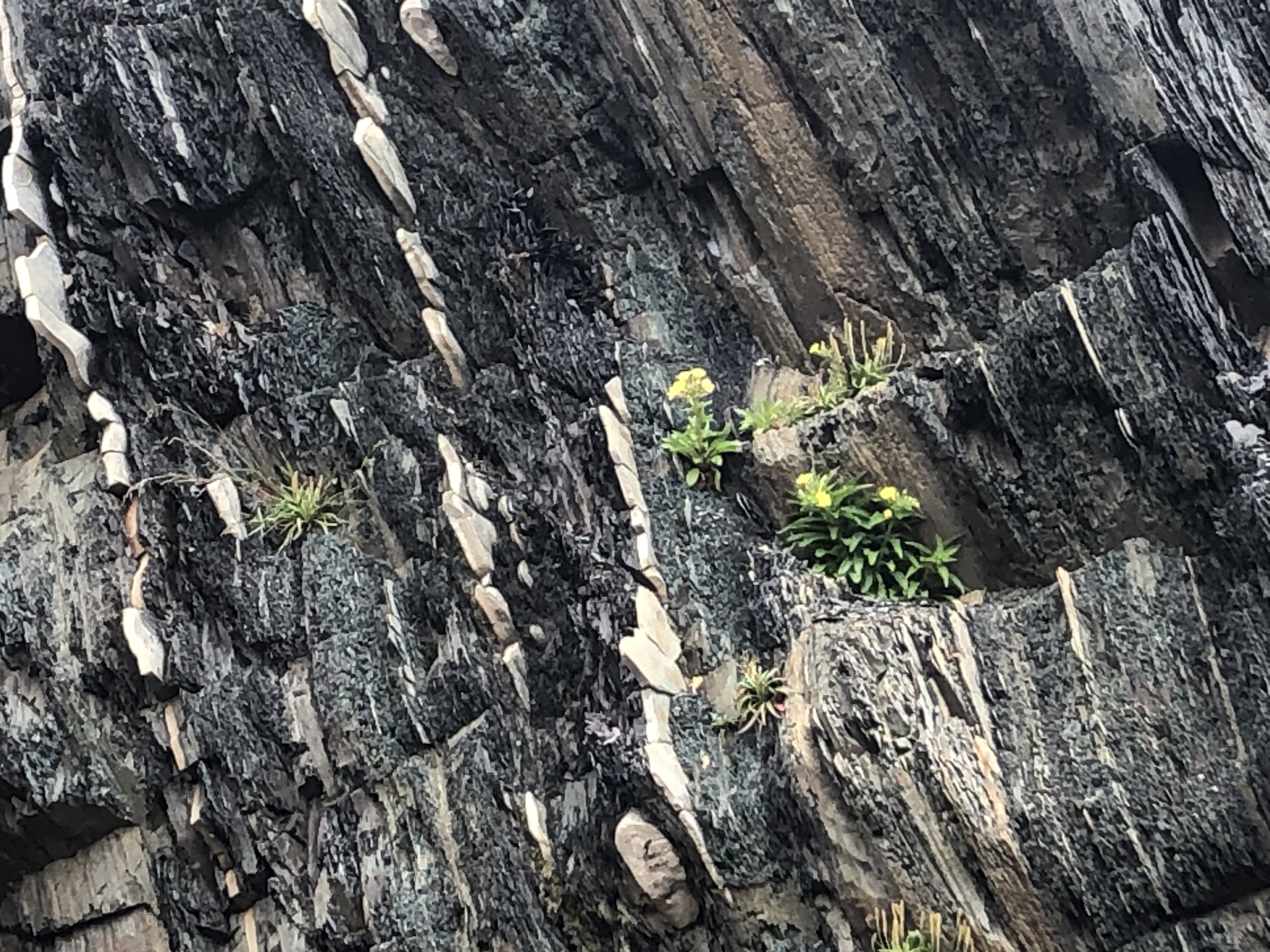Last month, my husband and I spent a week hiking and sight-seeing in Gros Morne National Park on the west coast of Newfoundland. Gros Morne has been designated a UNESCO World Heritage Site because of its spectacular scenery and its geological history. (Here’s a quick video tour.)
Newfoundland is a province of Canada located on a large island in the North Atlantic. It was formed more than 400 million years ago when land masses broken off from two other continents collided, pushing to the surface layers of ocean crust and earth’s mantle (think the layer just above the molten center). Over the next few million years, wave after wave of glaciers carved soaring cliffs and deep valleys into the ancient rock. I find it hard to wrap my mind around all that geological history, but it is an awe-inspiring place. One guidebook said, “What the Galapagos are to biology, Gros Morne is to geology.”
We visited Green Point Geological Site, an Atlantic beach where every third or fourth rock we picked up contained fossils. (Taking rocks home was strictly forbidden.) At Green Point the rocks in the cliffs were layered vertically instead of horizontally because millions of years ago, they had been pushed up from the bottom of the ocean and turned on end.
We took boat tours to see glacier-carved ocean and freshwater fjords where the cliffs towered 2000 feet above us and sometimes extended almost that deeply below the waterline. Bald eagles nested on the slopes. One afternoon we watched one eagle soar overhead with prey dangling from his mouth. As soon as he landed, his mate flew away from the nest in search of her own meal.
We hiked the Tablelands, one of the few places in the world where the earth’s mantle is exposed, creating a moonscape of rusting peridotite rocks. (Really, the rocks are rusting. Break one open, and it’s dark green inside.)
We squished our way through bogs where dozens of species of wildflowers including the carnivorous pitcher plant stretched as far as the eye could see. We hiked tundra-like slopes where berries and chanterelles grew in abundance and occasional clearings offered breathtaking views of the bay below us.
One word encapsulates my experience of that week in Gros Morne: awe. Awe is a sense of reverence, mystery and wonder that transcends understanding.
A few months ago I heard Krista Tippett interview psychologist Dacher Keltner, author of Awe: The New Science of Everyday Wonder and How It Can Transform Your Life. He’s been studying the experience of awe for most of his career. All humans experience awe, and awe is good for us as individuals and good for our society.
On the individual level, Dr. Keltner and his colleagues have found that experiencing awe activates the vagus nerve which in turn reduces blood pressure, slows the heart rate, and calms the nervous system. Experiences of awe also reduce the level of cytokines, chemical messengers which generate an inflammatory response in the body.
On a communal level, researchers have found that awe helps us to see ourselves as a small part of a larger whole. As Keltner put it “Awe binds us to social collectives and enables us to act in more collaborative ways that enable strong groups, thus improving our odds for survival. . . . Awe embeds the individual self in a social identity.” He said, “Awe. . . leads people to cooperate, share resources, and sacrifice for others, all of which are requirements for our collective life. And still other studies have explained the awe-altruism link: being in the presence of vast things calls forth a more modest, less narcissistic self, which enables greater kindness toward others.”[1]
The world might be a better place if more of us spent time trekking around Gros Morne National Park and other beautiful spots. Of course, we can’t spend every moment of our time doing that, but we don’t have to have extraordinary experiences to feel awe. People experience awe when we watch red and yellow leaves swirl around in the fall wind. We feel awe when we see light streaming through a brilliant stained-glass window. We are awed when we watch a newborn baby sleep or a puppy frolic in the grass.
Dr. Keltner offers several conditions under which we are likely to feel awe including time spent in nature, participation in religious rituals, and listening to music. He notes that we often experience awe when we see other people doing inspiring things such as overcoming obstacles or exercising courage or kindness. He calls these moments of “moral beauty.” We also experience awe in moments of “collective effervescence” such dancing together, singing along at a concert, or attending sporting events.[2]
I can’t spend every week in spectacular locations of natural beauty such as Gros Morne, but I can make space for more awe in my life. I can seek out conditions that are likely to create awe. Instead of moving through my days on auto-pilot, I want to pause more often to notice the awesome moments in my everyday life.
What about you? How do you create space for awe in your life?
[1] Dacher Keltner of Greater Good Science Center at Berkeley, neuroscientist, Interviewed by Krista Tippett, “On Being,” Feb. 2, 2023, https://onbeing.org/programs/dacher-keltner-the-thrilling-new-science-of-awe/
[2] For a quick overview of Dr. Keltner’s work, see https://greatergood.berkeley.edu/article/item/why_do_we_feel_awe




